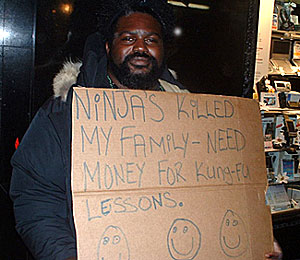I Know Gung-Fu
“Despite not speaking the language and asserting that ‘Chop Suey’ is a traditional dish in Mainland China, El Panda believes he is Chinese. His distorted interpretation of Chinese culture has developed through obsessively watching dubbed kung fu films and regularly visits to China Town.
“El Panda refuses to speak in any language other than Chinese. Unfortunately, El Panda does not know Chinese. El Panda communicates through indiscernible audible gibberish that he has hired an elder Chinese man to translate for others. Since El Panda isn’t really speaking Chinese, his Chinese translator invents translations as he sees fit.”
--From El Panda’s character bio on the side of the figure’s box.
Years ago, I told my friend John that I would send him a short story, and he said, “It would be awesome if you send a murder mystery and on the last page, there’s just a sheet of tinfoil with the words, ‘The murderer is you!’ or some shit like that.”
He was kidding.
I sent him the story, and I attached as the last page a sheet of tinfoil with the words, “The murderer is you!” even though the story was not a murder mystery and did not contain a murder or a murderer.
The fictional character, El Panda, is a Mexican luchador who happens to be a Sinophile in extremis. That his toy is produced by an American company (Muttpop) following a trend that had as its flashpoint, Hong Kong, late nineties, is easily ironic. That the trend itself (aka urban vinyl, aka art toys, aka designer toys) is often cited as a commingling of art and commerce is sort of like saying that the H3 Hummer is a commingling of environmental friendliness and brute, macho power.
First gross generalization: If the flashpoint of a particular trend happens anywhere near Hong Kong, then that trend has already succumbed to gross commodification.
But don’t take my word for it. Here is Michael Lau, in a 2004 New York Times Magazine article, commenting on the urban vinyl scene he’s credited with starting: “In a boring world, something happens and people hook on it, and Michael Lau created it.”
Note his use of the third person. That’s the way a professional wrestler talks. Note the tone in the stiff declaration, the style of a promo given to drum up ticket sales and excitement before a match.
Michael Lau is the godfather of the urban vinyl scene. He and fellow vinyl vanguard, Eric So, grew up poor in Hong Kong’s tenements, and a lot of their early work involve what’s described as street culture. Their drawings and, later, toy figures of teens dressed in baggy Levis and Air Jordans consumed the adult toy consumer. The toys, limited in production numbers, grew in value not only exponentially, but immediately with the help of eBay and an increasingly global market.
As with most trends, the designs of Lau, So, and other artists were copied (or "homaged") and then bootlegged, leading to a flurry of rotocast vinyl (from both Asia and the US) that has created a bubble as big as the one that enshrouded the American comic book industry in the mid-nineties, right before it blew up. Permanently. The parallels are striking. Back then, the American comic scene was glutted with new waves of ‘artists’ who had no sense of scale and depth and no understanding of basic human anatomy. Now, the vinyl scene is populated by many toy designers who have no sense of, well, art (second gross generalization).
Since the late nineties, many prominent vinyl designers have been signed up by Nike, Sony, Levi, and other big machines, and their characters, at least the Lau-inspired ones, feature an interesting mix of skateboard/street/hip-hop counterculture with a craving for material fulfillment. Designed by artists subsidized by corporations, these characters have since spawned exhibitions in France and London, and a bustling, thriving industry spurred on by eBay and all forms of commerce.
But what exactly is being celebrated at these shows?
To glibly point out the obvious contradictions of art toys that are sold and marketed like apparel or drapery (limited editions in the form of multiple colorways) is easy, but also insufficient.
What I like about El Panda, besides the degree of his cultural misappropriation, is the sheer exuberance of his Mao-loving lifestyle (especially given how much he costs). In a truly globalized world where political struggle becomes fodder for posters and T-shirts, merchandise is confused for art, and new mediums can rise and be commercialized and then devalued, all in less than a decade, the sense of haplessness and confusion is, if not justification for buying into the trend, at least an explanation for it.
I’m not a pudgy fan of lucha libre, nor do I particularly care for Mao suits, nor is there a sheet of figurative tinfoil staring me in the face, but I do feel like a comment is being made, on me, every time I look at the figure.
In the end, what I would like to say about El Panda, and the reason I spent too much money to acquire him, is that he's got soul. And yes, I realize I'm anthropomorphizing a block of rotocast vinyl.
What's more, the character description is really funny. Like, really, really funny. Like funnier than the character description of any other toy I've seen. Well, except for that of the GI Joe figure Skidmark.


